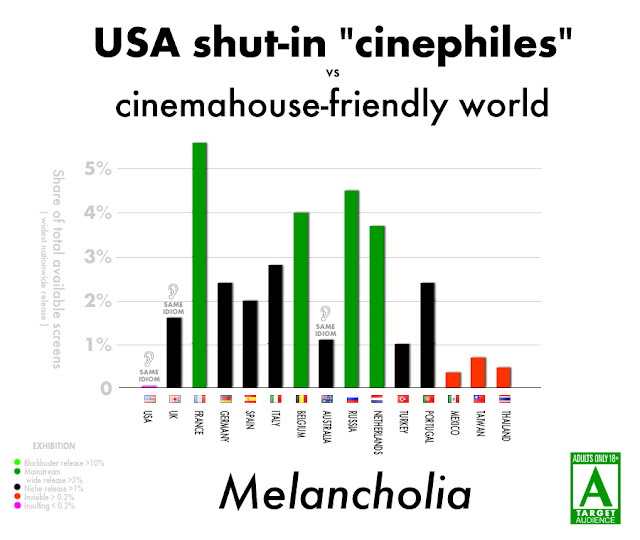"If the vaults were emptied, what would there be to look forward to? New movies, of course, which keep coming in at a dizzying rate—in quality as well as in quantity. But the grim history repeats itself at a pace to match, as it condemns some new work to an instant archival inaccessibility [..]
“I Wish I Knew,” from one of our era’s best younger directors, Jia Zhangke, which features interviews with actresses from earlier times, and which still has never been released here, either theatrically or on DVD. The list goes on [..] but how could one get to see them here?
Quantity matters desperately. [..]
It’s one thing for there to be crucially edifying cinematheques the world over, starting in Paris, but it would be all the greater for their treasures to be liberated from the constraints of geography and massively, rapidly transferred to video and made available to viewers with access to computers. [..]
The experience of seeing film prints projected on a screen in a movie theatre is indispensable [..] but the knowledge of the history of cinema shouldn’t be limited to those with access to the best repertory houses any more than a knowledge of art should be restricted to those who can travel to museums. [..]
Scarcity and the sense of the artificial event, created by a new release, are part of the fetishizing process; the world of total instant access would make classics not news but simply there, as much a second nature as a first language. It’s a crucial step—oddly, one still hard for many to take, more than a century into the age of cinema—for making and loving movies on their own distinctive terms."
Richard Brody redeems himself (see
previous episode) as a film critic who takes the responsibility of his job seriously.
Last Month he failed with an attempt to demonize Hollywood by pointing finger at an easy scapegoat, a harmless mediocre comedy (see:
“Movie 43” and Hollywood Exceptionalism), instead of criticizing the Hollywood system for its most ubiquitous output, the dominant payload that effectively clutters the horizon for moviegoers trapped within its culturally numbing barriers. No, that's not how you prove to be critical of an industry when you fire on an ambulance, and celebrate the most damaging puritan and jingoist censorship.
Thanksfullly, this time, his article does what EVERY respectable critic should do when living and working in a cultural environment so severely limited by a self-indulgent, patriotic, lazy, supply-demand artificial market. He writes in no uncertain terms that availability of certain films (old or contemporary niche) is a SERIOUS ISSUE in the USA. He's not the kind to take action, but at the very least, the duty of any journalist is to relay the problem on every possible media and as often as possible... until the situation DOES CHANGE for the better. Mentioning it once a year, because it's a slow capsule batch week, is clearly not enough. And pushing hands-on activists to take action, pushing the audience for their choice to be respected, pushing the distributor to be less wusses, pushing exhibitors to take chances on regular basis. That's what film critics who care about the dire situation their fellow moviegoers are in would do.
When a country the size of the USA cannot even give a minimum of 100 screens to ALL MAJOR releases of world cinema (which includes Festival winners, BO hits in foreign markets, American indies), it is cause for SERIOUS INTROSPECTION on the part of any film lover, professionals or private citizens, and for FUNDAMENTAL STRUCTURAL CHANGES too. There are enough mediocre mainstream flicks that bomb at the BO, that even the most unsophisticated audience rejects, and waste valuable theatre screen space, to make room for a bare minimum of CULTURAL DIVERSTY in the USA, and save a lot of wasteful spending in crap flick production and marketing at the same time!
Relegating the thousands of foreign films made each year to a cut-throat ghetto of a couple hundred screens nationwide is not a fatality of the market. France is not the only country that offers a safe haven. When comparing to European markets, to South America or Asia... the USA distribution system is not simply conservative and protectionist, it is dead last, far behind, even for some pretty obscure films. the USA market could still be largely profit-driven, way ahead of any other country on Earth, and still make room for a vital minority of films to propose a DIVERSE CHOICE to American moviegoers (even if they still will pick the crap blockbuster in mass), a fringe niche a little bigger than 10 screens at the time in NYC and LA, systematically!
Think about it. Do you want the USA to be the lowest supporter of cultural diversity? Or do you want it to rank nearer to the top of the list? Well, deserving a respectable cultural level is something that requires efforts, every day of the year. Obviously, reviewing only what safe, coward Hollywood distributors bring to your feet every week is not going to be enough. Responsible film critics, who think of themselves more than assembly line marketing blurb writers, should stop insulting the taste of their readers and bring world gems to American theatres THROUGHOUT the land.
Related :












